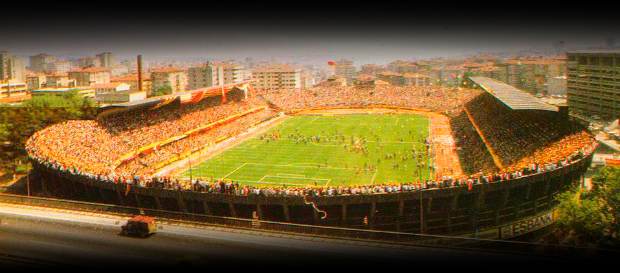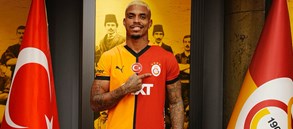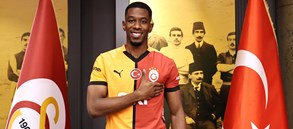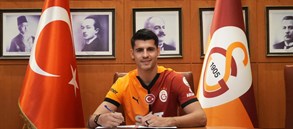Ali Sami Yen Stadium

In Istanbul, football was played for the first time by the British in a place called the Papazın Çayırı, where the current Fenerbahçe Stadium is now located. With the opening of Taksim Stadium in 1919, the new venue became the new center of football.
In 1939, within the scope of urban arrangement, the historical barracks including Taksim Stadium was demolished. Thus, there was not a stadium anymore. In this process, Fenerbahçe took the ownership of the land of the Papazın Çayırı and built Fenerbahçe Stadium there. Beşiktaş was transferred to the Şeref Stadium at the site of the current Çıragan Palace. In the same period, Galatasaray suffered most about the matter, without a stadium of its own to play matches.
The first step to overcome this problem was taken in the early 30s. The first attempt was made by Ali Haydar Barşal, the club chairman of the time, in 1933 to buy a mulberry land in Mecidiyeköy to Galatasaray.
As a result of negotiations with the state authorities between 1933-35, a land in Mecidiyeköy located outside the city was allocated for the stadium to be built for Galatasaray. In 1936, the excavation of the land began. Galatasaray received financial aid for this work from Adnan Menderes, the chairman of Turkish Sports Association of the time. However, the construction work stopped during the excavation stage.
In 1940, during the term of chairman Tevfik Ali Çınar, the subject of the stadium came up again. The same land was rented to Galatasaray for 30 years, symbolically for 1 Turkish lira per year. The right to use the land was officially owned by Galatasaray. Galatasaray gave guarantees to build a modern stadium and a bicycle velodrome when the land was rented.
However, construction could not be started due to lack of financial means and World War II. In 1943, the construction of a modest stadium that was needed started under the chairmanship of Osman Dardağan.
The stadium was opened in 1945 during the term of chairman Muslihittin Peykoğlu with the construction of a small tribune and a ground floor.
However, it was not possible to play football for a long time at the location because of the distance to the city center, transportation difficulties and very strong winds.
At the same time, with the opening of İnönü Stadium in the city center, Galatasaray left this stadium in Mecidiyeköy while stadium construction project was also failing once again. In 1955, the right to use agreement was extended until 2007, adding 30 more years to the remaining 22 years in the contract.
The General Directorate of Physical Education took over the job to fulfill the guarantees given for the stadium by the club. In 1959, construction began. During the term of chairman Refik Selimoğlu in 1961, a new agreement was made with the General Directorate of Physical Education and the using right of the stadium, which was being constructed, was given to Galatasaray.
Stadium opened on December 20, 1964 eventually. As a result of panic in the stands due to overcrowding during the opening ceremony, a person was killed and 80 people were injured.
The stadium had an operating lighting system in 1965. However, not many night games were played.
İnönü Stadium was used again in the early 1970s and stadium was abandoned for a while.
In the 70s, it was mostly used by Galatasaray for training. During these years, it was abandoned in terms of professional games.
In 1981, the ground was germinated and the stadium re-opened.
In 1993, the lighting system was renewed and night games started to be played again.
The same year, first time a combined ticket system in Turkey was launched at the Ali Sami Yen.
In the same year, the seat system was introduced. The standing capacity of the audience was approximately 35,000 and it decreased to 22,000.
In 1997, Galatasaray board delegated a Canadian architectural firm to Turkey's first multi-purpose, modern stadium project on the land of Ali Sami Yen, which was going to be demolished.
In 1998, the stadium was launched and attracted great attention. During the launch, all modern lodges were sold symbolically.
The search for financing for the construction of the new stadium began. Due to the difficult financial situation of the club, the required funding could not be found.
In 2001-2002, the project that announced was modified in order to minimize the need for financing and the costs were lowered but the problem of finding financing could not be overcome due to the 2001 economic crisis.
In the 2003 -2004 season, the old project was revived. Ali Sami Yen was abandoned with the decision to make a new and modern stadium. However, the financing requirement was not met again.
Since Mecidiyeköy is now in the center of the city, the state authorities opposed the enlargement of the stadium in this area. Alternatively, a new land was proposed to Galatasaray. During the period of 2004-2007, the search for the financing of the new land and the new stadium was continued.
After a general renovation in the 2004-2005 season, Galatasaray returned to Ali Sami Yen once again.
Following the 1999 earthquake, due to the danger, the Eski Açık Tribune was demolished and rebuilt in the 2005-2006 season. Eski Açık Tribune’s rebuilding was completed during the 2005 – 2006 season. During the third week of that season tribune opened for service with Malatyaspor match.
On January 11, 2011 Ali Sami Yen Stadium hosted the final official match of its history against Beypazarı Şekerspor. Galatasaray moved to Türk Telekom Stadium after that game.













































